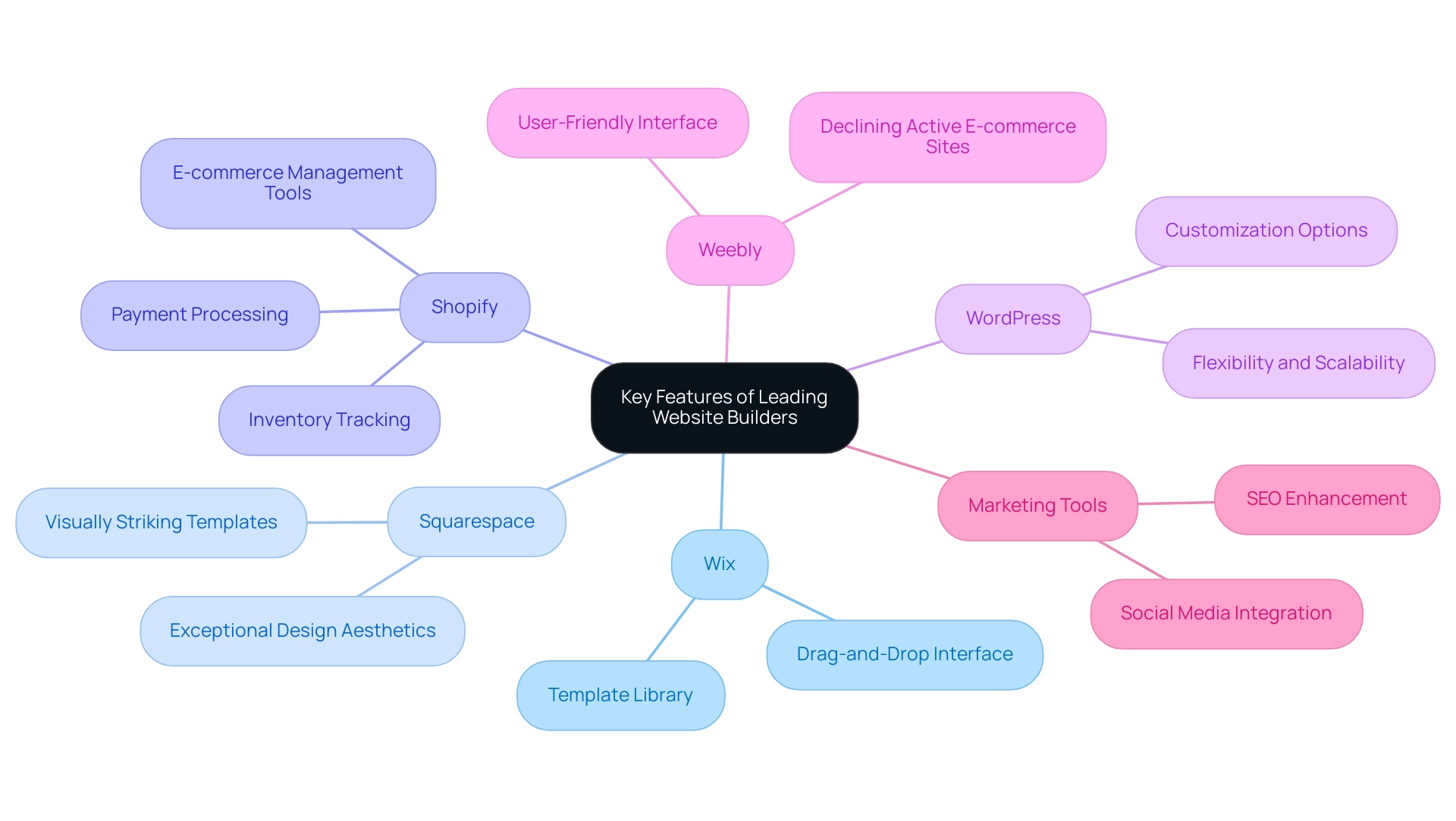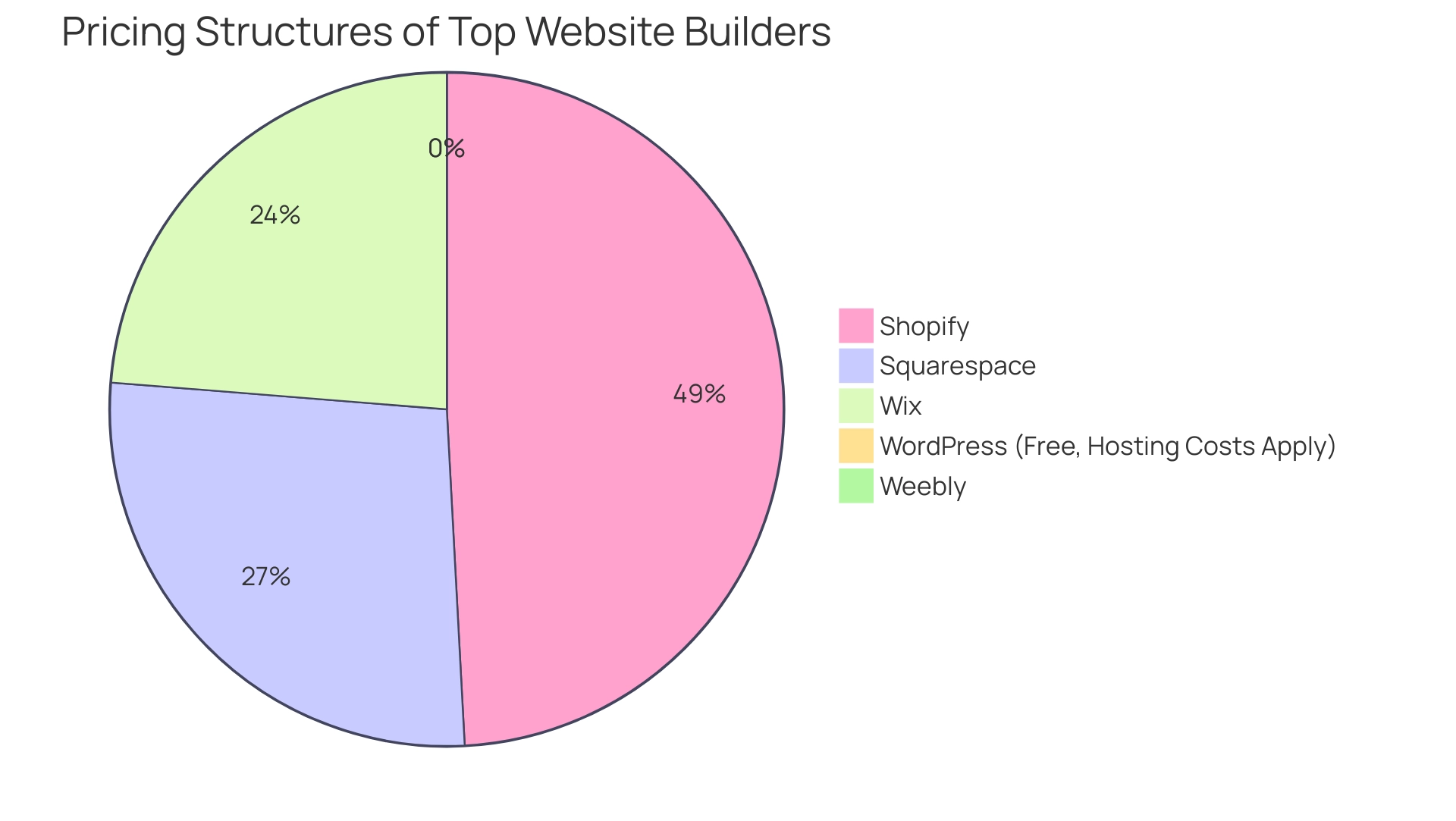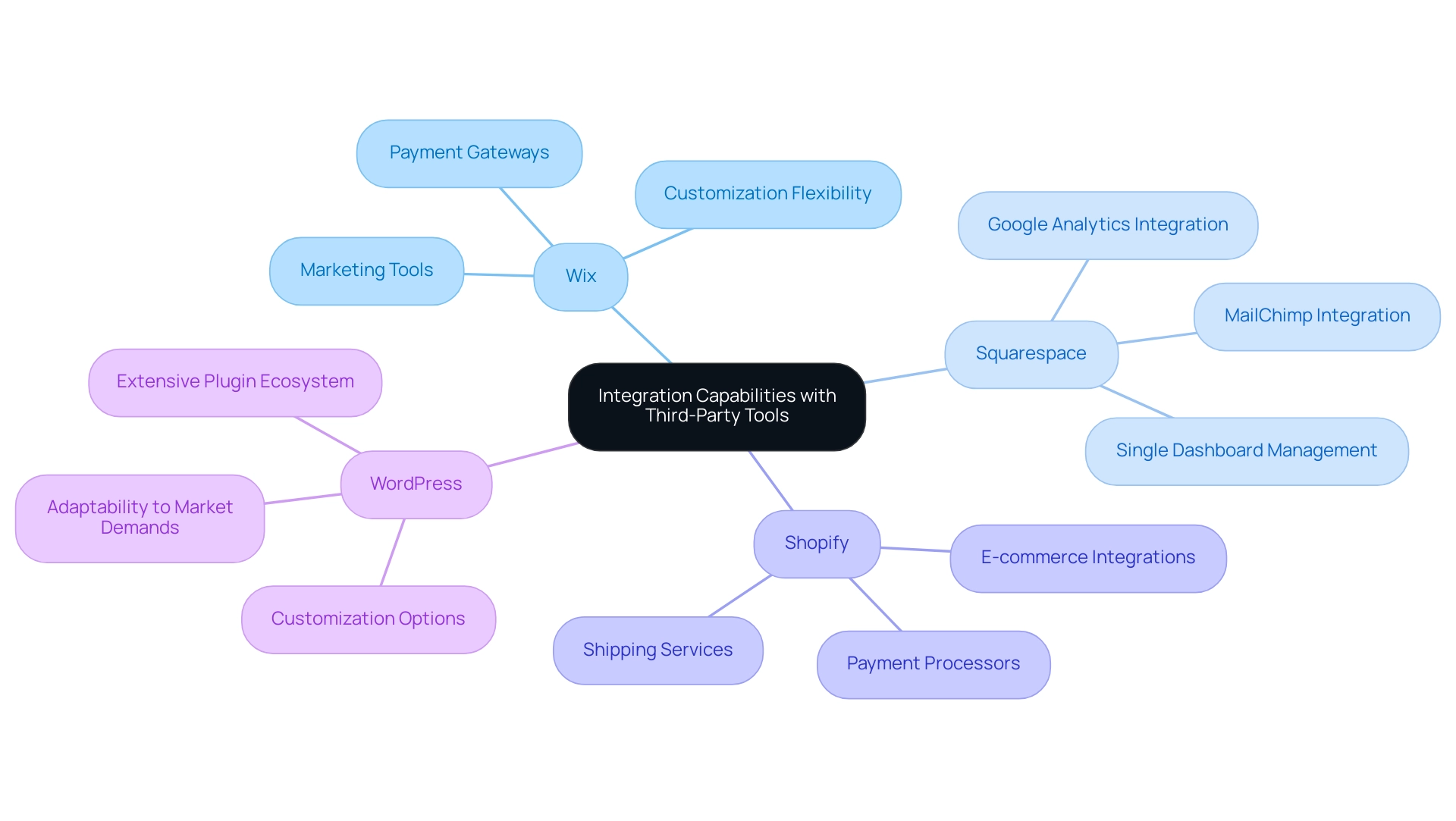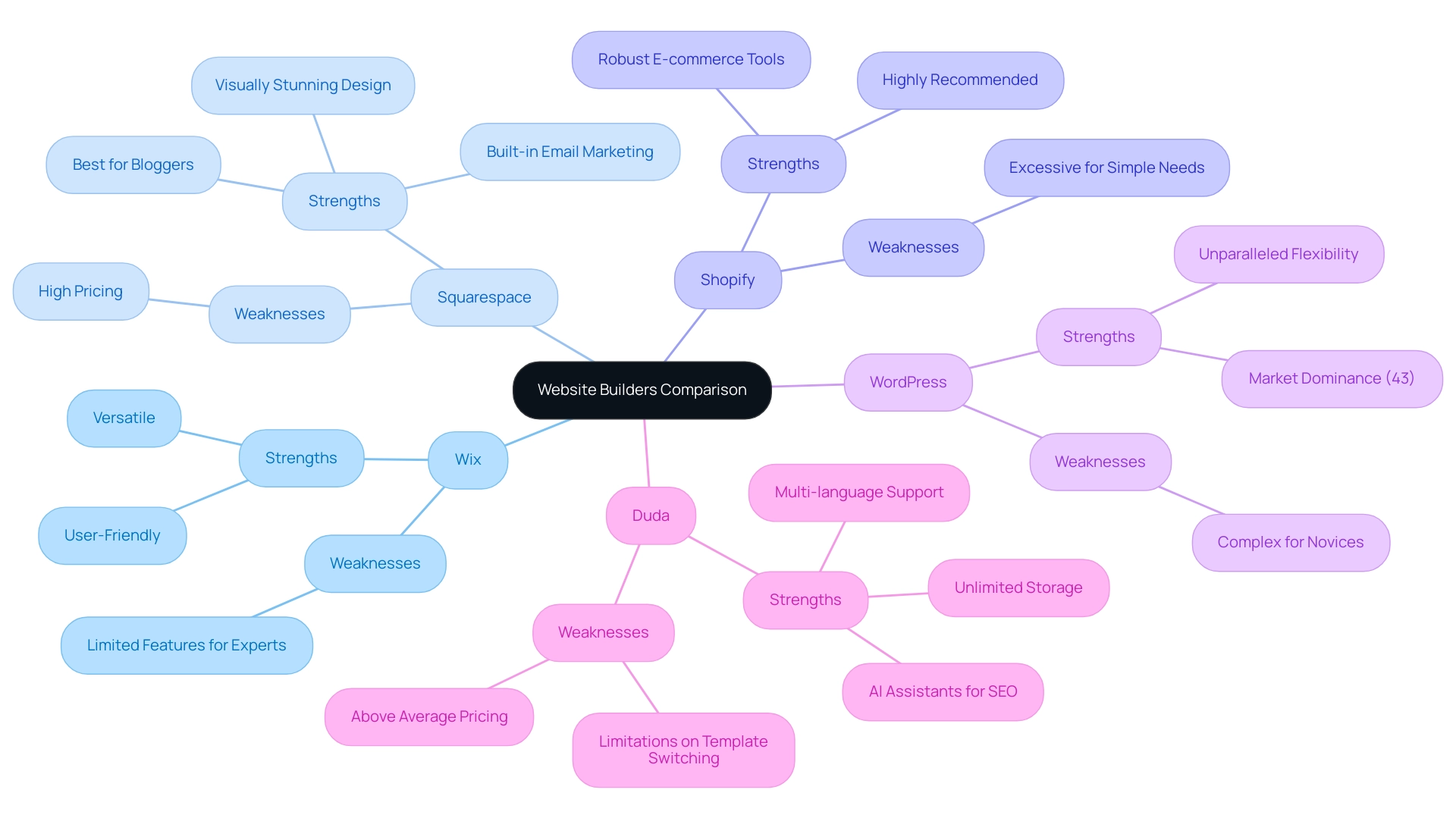Digital Branding Strategies
Comparing the Leading Website Building Companies: Features, Pricing, and Performance Insights
Overview
This article provides a comprehensive comparison of leading website building companies, meticulously examining their features, pricing, and performance insights. It serves as a valuable guide for users in selecting the most suitable platform tailored to their specific needs. Notably, platforms like Wix are recognized as ideal for beginners, thanks to their user-friendly design. In contrast, Shopify stands out for its exceptional e-commerce functionalities, while WordPress is celebrated for its extensive customization options. The emphasis on aligning platform choice with specific user requirements and business objectives is crucial, ensuring that users make informed decisions that drive success.
Introduction
In 2025, the landscape of website building has evolved into a dynamic arena, offering a multitude of platforms that cater to a diverse range of user needs—from budding entrepreneurs to established enterprises. As technology progresses, tools such as Wix, Squarespace, Shopify, and WordPress not only enhance user accessibility but also integrate cutting-edge features like AI-driven solutions and no-code options. These innovations empower even the least tech-savvy individuals to create professional websites with ease.
Given the increasing emphasis on mobile optimization and search engine performance, it is crucial for brand managers to understand the strengths and weaknesses of these platforms to elevate their online presence effectively.
This exploration will delve into current trends, pricing structures, and performance metrics of leading website builders, providing valuable insights for businesses navigating this competitive digital landscape.
Overview of the Website Building Landscape
The online development environment in 2025 presents a diverse array of platforms designed to meet the varied needs of individuals, from small enterprises to large corporations. Leading website building companies such as Wix, Squarespace, Shopify, and WordPress offer distinct features and capabilities, catering to different preferences and requirements. A notable trend is the rise of AI-driven tools and no-code solutions, which have significantly democratized web development, enabling those without technical expertise to create professional-grade online platforms effortlessly.
As companies increasingly recognize the importance of mobile optimization and search engine optimization (SEO), the features emphasized by these platforms have adapted accordingly. Effective web design not only enhances user engagement but also improves SEO by optimizing site navigation and speed—critical factors in search rankings. Research indicates that individuals form a judgment about an online platform in just 0.05 seconds, underscoring the necessity for a visually appealing and functional design.
Moreover, the average page speed for sites appearing on the first page of Google search results is 1.65 seconds, highlighting the importance of speed in retaining user interest. Statistics reveal that design costs typically range from $1,000 to $1,500 at over a third of agencies, with approximately 80.7% of projects taking around a month to complete. This underscores the competitive nature of the market and the importance of selecting website building companies that align with specific objectives and audience engagement strategies.
For instance, WonderEight’s collaboration with Quaker Oats to develop a tailored brand strategy exemplifies how effective branding can enhance a company’s online presence and market performance. WonderEight offers a range of services, including customized web design, branding strategies, and digital marketing solutions, ensuring that organizations can effectively convey their unique value propositions.
As we delve into the current trends and comparisons among website building companies in 2025, it becomes evident that understanding these dynamics is crucial for brand managers aiming to enhance their online presence. WonderEight’s commitment to blending creativity with technology positions it favorably to meet the evolving needs of businesses in this competitive landscape.
Key Features of Leading Website Builders
Leading online builders offer a diverse array of features tailored to meet various user requirements. Wix distinguishes itself with its user-friendly drag-and-drop interface and an extensive library of templates, making it particularly suitable for beginners eager to create a website swiftly and effortlessly. In contrast, Squarespace is renowned for its exceptional design aesthetics, providing visually striking templates that resonate with creative professionals and businesses striving for a polished online presence.
Shopify has emerged as the premier choice for e-commerce, equipped with robust tools that facilitate the management of online stores, encompassing everything from inventory tracking to payment processing.
Meanwhile, WordPress delivers unparalleled flexibility and scalability, positioning itself as the preferred platform for individuals seeking more complex site functionalities and customization options.
Beyond their core features, each platform integrates a suite of marketing tools that significantly enhance their overall effectiveness. For instance, SEO enhancement features and seamless social media integration are standard across these platforms, empowering users to optimize their online presence and engagement.
Recent statistics reveal that Weebly and Squarespace rank among the most favored site-creation platforms in the United States. Notably, Weebly has experienced a significant decline of 18% in active e-commerce platforms year-over-year, totaling 37,934 active sites as of March 11, 2025. This trend underscores the competitive landscape of website-building companies and the critical importance of selecting a platform that aligns with specific business objectives. Case studies further validate the effectiveness of these platforms.
For example, WonderEight’s comprehensive campaign for Quaker Oats not only showcased the product’s health benefits but also leveraged digital marketing strategies that substantially improved brand perception and sales. Additionally, the agency’s success stories, such as the brand identity uplift for Castania and the digital campaign for Motorola, exemplify their capacity to deliver impactful results.
Moreover, industry-standard tools like Figma, Sketch, Invision, Framer, and Miro, as noted by GeeksforGeeks, are frequently employed by web designers to enhance workflow and design capabilities. Such examples illustrate how the right online platform, in conjunction with effective design tools and marketing strategies, can play a pivotal role in executing successful marketing campaigns and enhancing brand identity.

Pricing Structures of Top Website Builders
The pricing models among online platforms exhibit considerable diversity, meticulously crafted to accommodate various budgets and needs. For instance, Wix offers a free plan with limited features, while its premium options commence at approximately $14 per month, unlocking additional functionalities such as e-commerce capabilities. In contrast, Squarespace initiates its pricing at $16 per month, which includes hosting and a complimentary domain for the first year, rendering it an appealing choice for those in search of an all-in-one solution.
Shopify, with its specialization in e-commerce, starts at $29 per month, reflecting a robust suite of features tailored for online retail. Meanwhile, WordPress is free to use; however, individuals should consider costs for hosting and premium themes, which can substantially affect the overall expenditure. This underscores the importance of evaluating total costs when comparing various platforms.
In 2025, the average price of online creation tools continues to evolve, with many designers—25% of those with over a decade of experience—charging between $2,000 and $4,000 for custom projects. This trend highlights the value of investing in quality design and functionality.
When scrutinizing the pricing models of leading platforms like Wix, Squarespace, and Shopify, it becomes apparent that each caters to distinct market segments. For example, Wix’s flexible pricing model allows individuals to scale their services as needed, while Squarespace’s structured approach appeals to those who prioritize aesthetics and simplicity. Shopify’s pricing underscores its focus on e-commerce, providing essential tools for businesses striving for success online.
Moreover, user aesthetic preferences significantly influence their choice of online platforms. Styles such as Boho and Chic resonate with creatives seeking warmth and individuality, whereas Trendy Black & White designs attract minimalists. Understanding these preferences can aid brand managers in selecting the appropriate platform.
Additionally, the mention of Weebly’s structured editor, which permits elements to be repositioned solely within a pre-designed grid, accentuates the usability aspect of site creation tools, further enriching the discussion on features.
Furthermore, a case study on cloud-based solutions in investor relations software reveals that in 2024, cloud-based solutions dominated as the deployment mode for investor relations site creation software, accounting for 75% of the market share. This trend is propelled by advantages such as automatic updates, enhanced security, and cost-effectiveness, particularly among large enterprises.
As of July 2024, Northern Europe leads the globe in internet penetration, with over 97.5% of its population online. This statistic emphasizes the growing significance of online creation tools in a highly connected market, making it imperative for brand managers to stay informed about these trends.
In conclusion, grasping these pricing structures and associated features is crucial for brand managers aiming to select the most suitable tool from website building companies for their requirements.

Performance Insights: Speed, Uptime, and User Experience
Performance insights reveal notable distinctions among leading builders in 2025. Wix stands out with an impressive uptime rate, ensuring that online platforms remain consistently accessible to users, which is crucial for maintaining engagement and reducing bounce rates. Squarespace also demonstrates strong performance metrics, particularly excelling in speed and reliability, making it a solid choice for visually-driven brands.
Shopify’s infrastructure is specifically optimized for e-commerce, delivering fast load times that are essential for online sales, thereby enhancing the shopping experience and potentially increasing conversion rates. In contrast, WordPress performance can fluctuate based on hosting choices; however, with proper optimization, it can achieve remarkable speed and uptime, making it a versatile option for various business needs.
User experience is further enhanced across all platforms through responsive design capabilities, ensuring seamless access on mobile devices. This adaptability is increasingly important, as mobile traffic continues to dominate web usage. Notably, the top organic result on Google’s SERP boasts an average click-through rate of 27.6%, underscoring the significance of online performance in driving traffic and engagement.
Additionally, Google.com has an average load speed of just 0.77 seconds, highlighting the critical role of speed in user retention and satisfaction.
As Patrick Trayes, Associate Director of Client Analytics, states, “Whether you’re looking to evaluate the performance of your upcoming redesign, set benchmarks for ongoing analysis or implement custom analytics, ZAG is ready to assist.” This highlights the significance of analytics in comprehending and enhancing online performance.
In examining case studies, companies that streamlined their call-to-action processes, enhanced product listings with visuals, and simplified the checkout process reported improved conversion rates. These strategies emphasize the direct correlation between online performance metrics and business success. Consequently, brand managers must prioritize uptime and speed when selecting an online platform offered by website building companies to ensure optimal performance and customer satisfaction.
User-Friendliness: Navigating Website Builders
User-friendliness is a critical factor when selecting a builder, varying significantly across platforms. Wix stands out with its intuitive drag-and-drop interface, empowering users to create online pages effortlessly, even without coding skills. This ease of use is reflected in user feedback, with many praising its accessibility for beginners.
In 2025, Wix continues to garner high user-friendliness ratings, solidifying its position as a top choice for those seeking a straightforward website creation process.
While Squarespace offers a more intricate experience, it provides a refined editing platform that caters to design-focused individuals. Its visually appealing templates and robust customization options enhance the user experience, though some may find the learning curve steeper compared to Wix.
Shopify excels in user-friendliness for e-commerce, featuring a dashboard specifically designed for efficient product and sales management. Abhijeet Kumar, owner of Book Blabber, states, “Yes, I would absolutely recommend Shopify to others,” underscoring its effectiveness for businesses aiming to establish an online store without the burden of technical complexities.
In contrast, WordPress, renowned for its powerful capabilities, presents a more challenging learning curve, particularly for those unfamiliar with content management systems. Although it offers extensive customization and flexibility, newcomers may require additional time to navigate its features effectively.
Statistics indicate that the average time spent on a page view is between 52 and 54 seconds, highlighting the importance of a user-friendly interface in retaining visitor engagement. Thus, the selection of a platform should align with the user’s technical comfort level and specific requirements, ensuring that the chosen tool not only meets their needs but also enhances the overall user experience.
Furthermore, the agency has been evaluating and ranking online creation tools for nearly a decade, providing valuable insights into their effectiveness. Case studies further illustrate these points; for instance, the comprehensive campaigns developed by WonderEight for brands like Miranda and Quaker Oats demonstrate how effective design can significantly enhance brand visibility and consumer connection. Additionally, to utilize a custom domain and eliminate Canva branding, users must acquire the Canva Pro plan for $119.99/year, which is pricier than other one-page platforms.
These insights underscore the significance of selecting a platform that balances user-friendliness with the essential functionalities needed to achieve commercial objectives.
Integration Capabilities with Third-Party Tools
Integration capabilities serve as a pivotal differentiator among online builders in 2025. Wix stands out by supporting a diverse array of third-party applications, including essential marketing tools and payment gateways, significantly enhancing its overall functionality. This flexibility enables companies to customize their websites to address specific needs, ultimately enhancing engagement and conversion rates.
Squarespace also excels in this area, offering seamless integrations with popular services such as MailChimp and Google Analytics. These integrations are particularly beneficial for marketers aiming to streamline their campaigns and analyze performance metrics effectively. The ability to manage marketing efforts from a single dashboard is increasingly vital, allowing for real-time updates and integrated analytics, which are crucial for informed decision-making.
Shopify, on the other hand, is renowned for its e-commerce integrations, providing effortless connections with various payment processors and shipping services. This capability is essential for enterprises focused on online sales, as it simplifies the transaction process and enhances customer satisfaction.
WordPress distinguishes itself through its extensive plugin ecosystem, enabling users to customize their sites with virtually any functionality they require. This level of flexibility is essential for website building companies that seek to optimize their online presence and adapt to changing market demands.
Notably, the employment of web developers and designers is projected to increase by 16% from 2022 to 2032, underscoring the growing importance of skilled professionals in leveraging these integration capabilities effectively. Furthermore, as of 2024, 75% of the Investor Relations Website Builder Software Market was deployed using cloud-based solutions, reflecting a significant trend towards scalable and efficient web solutions.
Case studies, such as the comprehensive campaigns developed for Mirinda and Quaker Oats by WonderEight, illustrate the impact of effective integrations. These campaigns successfully resonated with target audiences, enhancing brand loyalty and market presence. Such examples emphasize the significance of selecting a platform that not only accommodates third-party tool integrations but also aligns with broader marketing strategies.
As Matt Loy, an IT expert, highlights, “His strategic approach and varied expertise in commerce and technology allow him to provide innovative solutions and concrete results in challenging situations.” This perspective reinforces the necessity of integrating third-party tools effectively.
In conclusion, as businesses increasingly acknowledge the significance of third-party tool integrations in website building companies, it will be essential to choose a system that provides strong integration features, along with a unified dashboard for content management and integrated analytics, to attain measurable results and foster business success.

Comparative Analysis: Strengths and Weaknesses
When evaluating the leading website builders, distinct strengths and weaknesses come to light. Wix stands out for its user-friendly interface and versatility, making it an excellent choice for beginners. However, it may fall short for experienced individuals seeking more sophisticated features.
In contrast, Squarespace is renowned for its visually stunning design capabilities, appealing particularly to creatives; yet, its pricing can be higher than that of its competitors, which may deter budget-conscious users. Notably, Squarespace is considered the best choice for bloggers and writers, with plans starting at $16/month, offering built-in email marketing and essential e-commerce features.
Shopify excels in the e-commerce realm, offering robust tools for online selling. This specialization can render it excessive for those needing only a simple platform. As Abhijeet Kumar, Owner of Book Blabber, states, “Yes, I would absolutely recommend Shopify to others,” highlighting its effectiveness in the e-commerce space. Meanwhile, WordPress is celebrated for its unparalleled flexibility and extensive customization options, powering over 43% of all online platforms, which underscores its market dominance. However, its complexity can be intimidating for novices, potentially hindering their ability to create and manage a site effectively.
Each platform presents unique advantages tailored to different user requirements and levels of technical expertise. For example, Duda, a platform designed specifically for agencies, offers features like unlimited storage, multi-language support, and AI assistants for SEO and content, making it a strong contender for those needing a comprehensive solution. Its extensive features and templates enhance its appeal, although its pricing on lower-tier plans tends to be above average.
Ultimately, the choice of a website builder from different website building companies should align with individual goals and capabilities, as each option brings its own set of strengths and challenges to the table. Additionally, common elements such as live chat features and mobile responsiveness are essential considerations for individuals across all platforms.

Recommendations Based on User Needs and Scenarios
For individuals and small enterprises prioritizing simplicity and user-friendliness, Wix emerges as the premier choice. Its intuitive interface empowers users to create personal websites or small enterprise platforms with minimal technical expertise. In contrast, Squarespace caters to creatives seeking visually stunning designs, offering a diverse range of templates that enhance aesthetic appeal without sacrificing functionality.
For businesses with a strong focus on e-commerce, Shopify serves as the optimal solution. It provides powerful tools designed specifically for online selling, simplifying inventory management, payment processing, and the optimization of online stores for conversions. Conversely, WordPress stands out as the best choice for those requiring extensive customization and control, particularly for blogs or intricate online platforms. Its flexibility allows individuals to tailor their platforms to meet specific needs, supported by an extensive collection of plugins and themes.
Ultimately, the selection of website building companies hinges on individual requirements, financial constraints, and levels of technical ease. As the landscape of online building evolves, these companies must embrace innovation and leverage new technologies to achieve excellence in web design. Notably, with 53% of mobile users abandoning sites with sluggish load times, the significance of fast-loading platforms cannot be overstated, as it profoundly impacts audience engagement and retention.
In 2025, leading website building companies will continue to evolve to meet individual needs, with platforms like Wix and Shopify at the forefront, offering customized solutions for small enterprises. Additionally, Weebly reported having 37,934 active online platforms as of March 11, 2025, underscoring its relevance in the market. Case studies reveal that 90% of internet users in the US recognize the importance of online privacy, highlighting the necessity for companies to choose platforms that prioritize data security and consumer trust.
This focus not only enhances brand reputation but also influences sales outcomes, making the selection of website building companies a critical decision for any business. As Maria Harutyunyan aptly noted, ‘Oops! Something went wrong while submitting the form,’ underscoring the importance of seamless user experiences in website building.
Conclusion
The exploration of website builders in 2025 reveals a landscape rich with diverse options tailored to meet specific user needs and preferences. Platforms such as Wix and Squarespace provide user-friendly interfaces and visually appealing designs, making them ideal for beginners and creatives. Shopify emerges as the premier solution for e-commerce, offering robust tools that streamline online selling processes. In contrast, WordPress delivers unmatched flexibility, catering to those who require extensive customization for their websites.
Understanding the pricing structures is paramount, as they vary significantly across platforms, directly impacting overall expenditure. With average costs of website design on the rise, brand managers must scrutinize the total expenses associated with each platform to ensure alignment with their budget and objectives. Performance metrics, including speed and uptime, further influence user experience, highlighting the necessity of selecting a platform that guarantees optimal functionality and engagement.
Ultimately, the choice of website builder should mirror individual goals, technical comfort levels, and the unique requirements of the business. As the digital landscape evolves, prioritizing mobile optimization, fast load times, and seamless integration capabilities with third-party tools becomes essential for enhancing online presence. By making informed decisions based on these insights, businesses can adeptly navigate the competitive arena of website building and secure lasting success in their digital endeavors.
Frequently Asked Questions
What are the main website building platforms mentioned for 2025?
The main website building platforms mentioned are Wix, Squarespace, Shopify, and WordPress, each offering distinct features tailored to different user needs.
How have AI-driven tools and no-code solutions impacted web development?
AI-driven tools and no-code solutions have democratized web development, allowing individuals without technical expertise to create professional-grade online platforms easily.
Why is mobile optimization and SEO important for website building platforms?
Mobile optimization and SEO are important because they enhance user engagement and improve search rankings by optimizing site navigation and speed, which are critical factors in retaining user interest.
How quickly do users form judgments about online platforms?
Research indicates that individuals form a judgment about an online platform in just 0.05 seconds, highlighting the necessity for a visually appealing and functional design.
What is the average page speed for sites on the first page of Google search results?
The average page speed for sites appearing on the first page of Google search results is 1.65 seconds.
What are the typical design costs and project timelines for website development?
Design costs typically range from $1,000 to $1,500 at over a third of agencies, with approximately 80.7% of projects taking around a month to complete.
Can you provide an example of effective branding in web development?
An example of effective branding is WonderEight’s collaboration with Quaker Oats to develop a tailored brand strategy, enhancing the company’s online presence and market performance.
What distinguishes Wix from other website builders?
Wix is distinguished by its user-friendly drag-and-drop interface and extensive library of templates, making it suitable for beginners looking to create a website quickly.
What are Squarespace’s strengths as a website builder?
Squarespace is known for its exceptional design aesthetics, providing visually striking templates that appeal to creative professionals and businesses seeking a polished online presence.
What makes Shopify the preferred choice for e-commerce?
Shopify is the premier choice for e-commerce due to its robust tools that facilitate online store management, including inventory tracking and payment processing.
Why is WordPress favored for complex site functionalities?
WordPress is favored for its unparalleled flexibility and scalability, making it ideal for individuals seeking complex site functionalities and customization options.
What additional features do these platforms offer to enhance effectiveness?
These platforms integrate a suite of marketing tools, such as SEO enhancement features and seamless social media integration, to empower users in optimizing their online presence.
What recent trend has been observed regarding Weebly’s active e-commerce platforms?
Weebly has experienced a significant decline of 18% in active e-commerce platforms year-over-year, totaling 37,934 active sites as of March 11, 2025.
What tools do web designers commonly use to enhance their workflow?
Industry-standard tools frequently employed by web designers include Figma, Sketch, Invision, Framer, and Miro, which enhance workflow and design capabilities.



